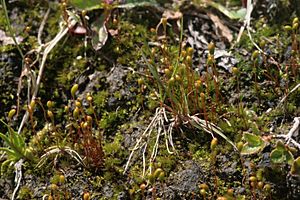Broad-nerved hump-moss facts for kids
Quick facts for kids Broad-nerved hump-moss |
|
|---|---|
 |
|
| Conservation status | |
| Scientific classification | |
| Genus: |
Meesia
|
| Species: |
uliginosa
|
Meesia uliginosa, also known as the broad-nerved hump-moss, is a special type of moss. It's considered rare in the Western United States. You can find this moss all around the northern hemisphere in colder, higher places. In some areas, it's not as rare as it is in the Western U.S.
What Does It Look Like?
This moss often grows in clumps. Its stems can be 1 to 4 centimeters (about 0.4 to 1.6 inches) long. The leaves are usually straight and narrow. They can be between ¾ and 4½ millimeters long. The edges of the leaves are often rolled back. A strong, wide vein runs through the middle of each leaf. This vein goes almost all the way to the leaf's rounded tip.
When the moss produces spores, it has a very long stalk, from 1½ to 10 centimeters (about 0.6 to 4 inches). The spore capsule is shaped like a pear and is a bit curved.
Where Does It Live?
This moss has a "bipolar distribution." This means it lives in both the Northern and Southern parts of the world. In the Northern Hemisphere, it's found across many northern regions. These include Greenland, Canada, the northern United States, the Baltic countries, Russia, and Mongolia. It also grows in South America and parts of Antarctica.
The broad-nerved hump-moss prefers to live in wet, spongy areas called fens. You can also find it on peaty soil banks, in wet meadows, or in cracks in rocks. It likes damp, organic soil in high mountain or cold, arctic regions. Sometimes, it grows in rich fens at lower elevations too. This moss can be found from about 3,950 feet up to 8,550 feet high.
Fires usually don't happen in fens because they are very wet. However, if there's a big fire nearby, the soot could harm the moss's home.
Protecting This Moss
The broad-nerved hump-moss is listed as a sensitive species by the U.S. Forest Service. It's also on the California Native Plant Society List 2.2. This means it's a plant that needs special care.
Fens are very delicate places. They can be easily damaged by things like:
- Grazing animals, like cows, walking on them.
- Changes to water flow, like building roads that block water.
- Building new roads or using old ones.
- Mining for peat, which is a type of soil made from decayed plants.
Rich fens are especially sensitive to changes. The water chemistry in these fens can be affected by weather changes or human activities.
How to Identify It
It can be tricky to tell Meesia uliginosa apart from a similar moss called M. triquetra. However, the broad-nerved hump-moss has a few key differences. It doesn't grow in three neat rows like M. triquetra. Its central leaf vein is wider, and its leaf edges are rolled back. Also, its leaf tips are blunt, not pointed.


